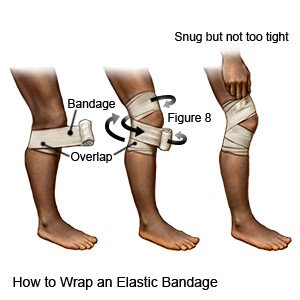Hamstring Injury
Medically reviewed by Drugs.com. Last updated on Apr 6, 2025.
What is a hamstring injury?
A hamstring injury is a bruise, strain, or tear to one of your hamstring muscles. Your hamstring muscles are in the back of your thigh and help bend and straighten your leg.
What increases my risk for a hamstring injury?
- Sports, or not warming up and stretching before activity
- Tired, stiff, or tight hamstring muscles
- Weak hamstring muscles
- Sudden increase in the amount of your training
- Unequal strength of hamstring muscles
What are the signs and symptoms of a hamstring injury?
You may start to feel symptoms when you rest after activity. You may have any of the following:
- Pain, swelling, or bruising
- Feeling a pop or tear
- Trouble bending or straightening your leg
- Loss of strength
How is a hamstring injury diagnosed?
An x-ray, ultrasound, CT, or MRI may show the hamstring injury. You may be given contrast liquid to help the injury show up better in the pictures. Tell the healthcare provider if you have ever had an allergic reaction to contrast liquid. Do not enter the MRI room with anything metal. Metal can cause serious injury. Tell the healthcare provider if you have any metal in or on your body.
How is a hamstring injury treated?
- Medicines can help decrease pain and swelling.
- Surgery may be needed if you have a severe strain or tear. You may also need surgery if you have pain or tightening that does not go away.
How can I manage my symptoms?
- Rest your hamstring muscles as directed.
- You may need to use crutches until you can put weight on your injured leg without pain. This will help decrease stress and strain on your hamstring muscles.
- Apply ice on the back of your thigh for 15 to 20 minutes every hour or as directed. Use an ice pack, or put crushed ice in a plastic bag. Cover it with a towel before you apply it. Ice helps prevent tissue damage and decreases swelling and pain.
- Wear an elastic bandage to help decrease swelling. It should be snug but not tight.

- Elevate your leg above the level of your heart as often as you can. This will help decrease swelling and pain. Prop your leg on pillows or blankets to keep it elevated comfortably.

- Go to physical therapy, if directed. A physical therapist teaches you exercises to help improve movement and strength, and to decrease pain.
How can I help prevent another hamstring injury?
- Ask when you can return to your usual activities. You may injure your hamstring muscles more if you start activity too soon.
- Warm up and stretch before and after you exercise. This helps loosen your muscles and decrease stress on your hamstring muscles. Slowly increase time, distance, and how often you train. A sudden increase may cause injury.
When should I seek immediate care?
- Your lower leg or foot is pale or blue, and feels cool when you touch it.
- You have severe pain.
- You cannot bend or straighten your leg.
When should I call my doctor?
- You have a fever.
- Your signs and symptoms do not improve with treatment.
- You have questions or concerns about your condition or care.
Care Agreement
You have the right to help plan your care. Learn about your health condition and how it may be treated. Discuss treatment options with your healthcare providers to decide what care you want to receive. You always have the right to refuse treatment. The above information is an educational aid only. It is not intended as medical advice for individual conditions or treatments. Talk to your doctor, nurse or pharmacist before following any medical regimen to see if it is safe and effective for you.© Copyright Merative 2025 Information is for End User's use only and may not be sold, redistributed or otherwise used for commercial purposes.
Further information
Always consult your healthcare provider to ensure the information displayed on this page applies to your personal circumstances.
